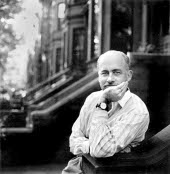 Peter
Quinn studied for a doctorate in history that he never finished, and
his literary career - which overlaps with three decades as a
political and corporate speech-writer - retains a deep curiosity
about the past.
Peter
Quinn studied for a doctorate in history that he never finished, and
his literary career - which overlaps with three decades as a
political and corporate speech-writer - retains a deep curiosity
about the past.
But it's not only history of the verified, annotated variety; it is history also imagined and remembered.
"What I really wanted to get at were the people who weren't on the record," Quinn said earlier this week. "They're just there as statistics, or death certificates. What was it like to be an individual? You can't do that as an honest historian. ... You have to rely on what's on the record. The truth of the matter is: Most of history isn't on the record."
Quinn - who will speak at St. Ambrose University on Thursday as part of the conference "The Global Irish: Conflict, Coexistence, & Community" - has written three books: the novels Banished Children of Eve (winner of an American Book Award) and The Hour of the Cat, and the essay collection Looking for Jimmy: A Search for Irish America.
While Quinn has tried to remain faithful to history, he said, "what I like about the historical novel is when the history runs out. That's great. ... That opens it up for the novelist."
Banished Children of Eve is set in 1863 New York City and concerns the Civil War and the New York Draft Riots. Quinn said that while there is a historical record concerning one of his characters, Stephen Foster (the "father of American music" who wrote "Oh! Susanna" and "Camptown Races"), it wasn't rich enough for him to write about meaningfully. "The only way I can reach him is in fiction," the author said. "I just have to let go of history."
The Hour of the Cat is a historical murder mystery. The premise, as told by the author: "What if instead of stumbling on a single murder, somebody stumbled on the greatest murder plot in history: the eugenic origins of the Holocaust?" Quinn's next book is a sequel, about the 1930 disappearance of New York Associate Supreme Court Justice Joseph Crater.
Last year's nonfiction Looking for Jimmy takes a similarly nonacademic approach to Irish-American history, using Quinn's family as an illustration of the immigrant experience.
"History happens above us, and it's like this big thing," said Quinn, who wrote speeches for two New York governors as well as executives at Time Warner before retiring last year. "And I wanted to interweave it with, 'What did it mean for my family?' Because we were part of the same experience. ... I found so many of the general things would be reflected in the particulars of my own family."
The "Jimmy" of the title is a personification of the integrated Irish, represented by Jimmy Walker (New York's mayor from 1926 and 1932) and the actor James Cagney. Quinn writes: "These Jimmies had the blend of musicality and menace, of nattiness and charm, of verbal agility and ironic sensibility, of what is known today as 'street smarts,' that the Irish, as New York's first immigrant outsiders, had developed.
"In their desire to belong, the Irish had created a behavior and bearing that was adapted to the pace and demands of the metropolis, a way of life totally different from what they had known in rural Ireland."
As the author summarized in our interview: "This disoriented, dispossessed, dislocated peasantry became the epitome of urban America," using labor unions, the Catholic church, and the Democratic party to meet their needs. "They had this whole urban structure, and it lasted as long as they needed it. And they've kind of moved on."
Quinn reminds readers that when millions of Irish immigrated to the United States in the 1840s because of famine, their arrival was met with the ugly "Paddy" stereotype - "an ignorant, shovel-wielding person," Quinn said. The Irish were viewed "as poster children for inferior species."
The level of hostility directed at the Irish was expressed by the English historian Edward Freeman, who wrote that the United States "would be a great land if only every Irishman would kill a negro, and be hanged for it."
The current immigration debate, Quinn said, recalls the public fear generated by 19th Century Irish immigration, and the early-20th Century arrivals of large numbers of Italians, Jews, and Slovaks
"The first great immigrant crisis in America was the result of the famine immigration," Quinn said. And with large numbers of immigrants, "there's a level of hysteria that comes in."
Quinn suggested that today's arguments against immigration will one day look as ridiculous as the Paddy vitriol does now: "We always get 50 years away and say, 'Oh, that was nuts.'"
Peter Quinn will speak at 6 p.m. on Thursday, April 17, in the Rogalski Center ballroom, at the corner of Ripley and Lombard streets in Davenport.
For more information on "The Global Irish: Conflict, Coexistence, & Community" conference, which runs April 16 through 19, visit (http://www.sau.edu/acis/).








